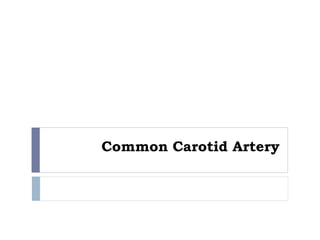Common carotid artery
- 2. ÔÅΩ differ in length and in their mode of origin. ÔÅΩ The right begins at the bifurcation of the innominate artery behind the sternoclavicular joint and is confined to the neck. ÔÅΩ The left springs from the highest part of the arch of the aorta to the left of, and on a plane posterior to the innominate artery, and therefore consists of a thoracic and a cervical portion.
- 4. ÔÅΩ At the lower part of the neck the two common carotid arteries are separated from each other by a very narrow interval which contains the trachea; ÔÅΩ at the upper part, the thyroid gland, the larynx and pharynx project forward between the two vessels. ÔÅΩ The common carotid artery is contained in a sheath, which is derived from the deep cervical fascia and encloses also the internal jugular vein and vagus nerve, the vein lying lateral to the artery, and the nerve between the artery and vein, on a plane posterior to both. ÔÅΩ On opening the sheath, each of these three structures is seen to have a separate fibrous
- 5. Relations ÔÅΩ At the lower part of the neck the common carotid artery is very deeply seated, being covered by the integument, superficial fascia, Platysma, and deep cervical fascia, the Sternocleidomastoideus, Sternohyoideus, Sternothyreoideus, and Omohyoideus; ÔÅΩ in the upper part of its course it is more superficial, being covered merely by the integument, the superficial fascia, Platysma, deep cervical fascia, and medial margin of the Sternocleidomastoideus. ÔÅΩ When the Sternocleidomastoideus muscle is drawn backward, the artery is seen to be contained in a triangular space, the carotid triangle, bounded behind by the Sternocleidomastoideus, above by the Stylohyoideus and posterior belly of the Digastricus, and below by the superior belly of the Omohyoideus.
- 6.  Behind, the artery is separated from the transverse processes of the cervical vertebræ by the Longus colli and Longus capitis, the sympathetic trunk being interposed between it and the muscles.  Medially, it is in relation with the esophagus, trachea, and thyroid gland (which overlaps it), the inferior thyroid artery and recurrent nerve being interposed; higher up, with the larynx and pharynx.  Lateral to the artery are the internal jugular vein and vagus nerve.
- 7. ÔÅΩ Behind the angle of bifurcation of the common carotid artery is a reddish-brown oval body, known as the glomus caroticum (carotid body).







